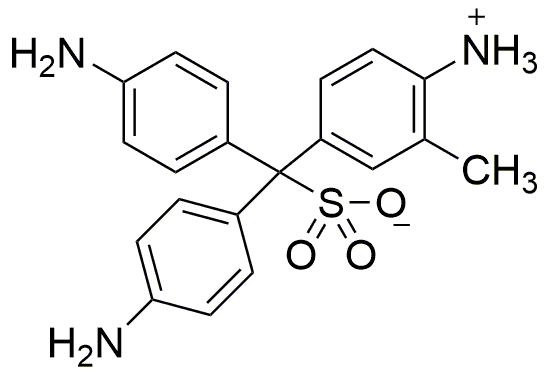Schiff’s fuchsin-sulfite reagent is widely utilized in research focused on:
- Histology and Microscopy: This reagent is essential for staining tissues, particularly in identifying aldehyde groups in biological samples, which helps in the visualization of cellular structures under a microscope.
- Microbiology: It is used to detect and differentiate various microorganisms, especially in identifying bacteria that produce polysaccharides, aiding in the diagnosis of infections.
- Environmental Testing: The reagent plays a role in assessing water quality by detecting the presence of aldehydes, which can indicate pollution or contamination in aquatic environments.
- Food Industry: It is applied in food testing to identify preservatives and additives, ensuring compliance with safety regulations and maintaining product quality.
- Research and Development: In chemical research, it serves as a valuable tool for synthesizing and characterizing new compounds, particularly in organic chemistry, enhancing the understanding of chemical reactions.
Información general
Propiedades
Seguridad y normativas
Aplicaciones
Schiff’s fuchsin-sulfite reagent is widely utilized in research focused on:
- Histology and Microscopy: This reagent is essential for staining tissues, particularly in identifying aldehyde groups in biological samples, which helps in the visualization of cellular structures under a microscope.
- Microbiology: It is used to detect and differentiate various microorganisms, especially in identifying bacteria that produce polysaccharides, aiding in the diagnosis of infections.
- Environmental Testing: The reagent plays a role in assessing water quality by detecting the presence of aldehydes, which can indicate pollution or contamination in aquatic environments.
- Food Industry: It is applied in food testing to identify preservatives and additives, ensuring compliance with safety regulations and maintaining product quality.
- Research and Development: In chemical research, it serves as a valuable tool for synthesizing and characterizing new compounds, particularly in organic chemistry, enhancing the understanding of chemical reactions.
Documentos
Hojas de datos de seguridad (HDS)
La SDS proporciona información de seguridad completa sobre la manipulación, el almacenamiento y la eliminación del producto.
Especificación del producto (PS)
La PS proporciona un desglose completo de las propiedades del producto, incluida la composición química, el estado físico, la pureza y los requisitos de almacenamiento. También detalla los rangos de calidad aceptables y las aplicaciones previstas del producto.
Certificados de análisis (COA)
Busque certificados de análisis (COA) ingresando el número de lote del producto. Los números de lote y de partida se pueden encontrar en la etiqueta de un producto después de las palabras "Lote" o "Lote".
Número de catálogo
Número de lote/lote
Certificados de origen (COO)
Este certificado de origen confirma el país en el que se fabricó el producto y también detalla los materiales y componentes utilizados en él y si se deriva de fuentes naturales, sintéticas u otras fuentes específicas. Este certificado puede ser necesario para cumplir con las normativas aduaneras, comerciales y regulatorias.
Número de catálogo
Número de lote/lote
Hojas de datos de seguridad (HDS)
La SDS proporciona información de seguridad completa sobre la manipulación, el almacenamiento y la eliminación del producto.
DownloadEspecificación del producto (PS)
La PS proporciona un desglose completo de las propiedades del producto, incluida la composición química, el estado físico, la pureza y los requisitos de almacenamiento. También detalla los rangos de calidad aceptables y las aplicaciones previstas del producto.
DownloadCertificados de análisis (COA)
Busque certificados de análisis (COA) ingresando el número de lote del producto. Los números de lote y de partida se pueden encontrar en la etiqueta de un producto después de las palabras "Lote" o "Lote".
Número de catálogo
Número de lote/lote
Certificados de origen (COO)
Este certificado de origen confirma el país en el que se fabricó el producto y también detalla los materiales y componentes utilizados en él y si se deriva de fuentes naturales, sintéticas u otras fuentes específicas. Este certificado puede ser necesario para cumplir con las normativas aduaneras, comerciales y regulatorias.


